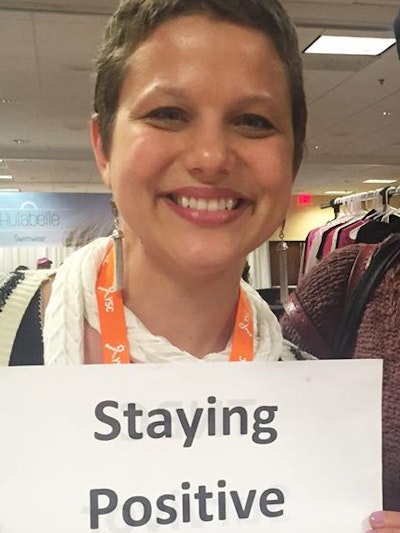The best word to describe the studies presented at the 2017 San Antonio Breast Cancer Symposium is probably…”promising.” While there were no really big leaps forward this year, researchers presented a number of clinical trial results that represent steady progress in treating TNBC. Trials utilizing PARP inhibitors, immunotherapy, chemotherapy and antibody-drug conjugates all produced positive results in patients with metastatic TNBC. There is also ongoing progress in the critical area of neoadjuvant therapy.
San Antonio Breast Cancer Symposium 2017
Promising Results on Several Fronts
Phase III EMBRACA Trial Meets its Primary Endpoint
EMBRACA is a trial designed for patients who have germline BRCA 1 or 2 mutations and advanced HER2 negative breast cancer. BRCA mutations occur in about 15 percent of people with TNBC. Patients with these mutations are often diagnosed at an earlier age than those with non-hereditary breast cancer. A number of studies have shown that PARP inhibitors are potentially effective in improving survival in breast cancer patients with BRCA mutations.
At this year’s SABCS, investigators announced the results of the Phase III EMBRACA trial. Phase III trials are conducted with large groups of patients after the treatments involved have been shown to be safe and effective in earlier, smaller trials. Their success (or failure) is usually measured by improvements in overall survival, disease free survival or progression free survival (PFS), the length of time from treatment to when the cancer begins to grow again.
EMBRACA compared the efficacy of the PARP inhibitor talazoraparib with the physician’s choice of chemotherapy in patients with locally advanced or metastatic TNBC. Patients receiving talazoparib had an average PFS of 8.6 months vs. 5.6 months in those getting chemotherapy. The overall response rate–those getting clinical benefit–was 62.6 percent in the PARP inhibitor group and 27.2 percent in the chemo group. Investigators also noted that the PARP group had a significantly longer time before they began to deteriorate clinically, 24.3 months vs. 6,3 months in the standard of care chemo group, an important finding for quality of life. There was a somewhat higher rate of serious side effects in the talazoparib group.
“We are pleased that the Phase III EMBRACA trial–the largest randomized clinical trial in patients with hereditary breast cancer met its primary endpoint of progression free survival,” said Jennifer Litton, MD, of the MD Anderson Cancer Center.
The successful Phase III trial means that there will be both additional trials and that talazoparib moves closer to FDA approval for treating patients with BRCA 1 and 2 mutations and advanced breast cancer.
Pembro/Eribulin Data Hold Up in Larger Study
In the last few years, there has been considerable interest and an increasing number of studies focused on using immunotherapy for TNBC. Early results produced response rates in the 20-30 percent range in patients with metastatic disease who had been treated with one or more prior chemo regimens. Researchers were particularly intrigued by the fact that some of these responses were durable–lasting months or even years.
The ENHANCE1/KEYNOTE study is a Phase 1b/11 trial to assess the efficacy of pembrolizumab and eribulin in combination in three groups of patients with metastatic TNBC. Unlike most trials, this one doesn’t involve a comparison with other forms of standard treatment. The two groups were women with mTNBC who had not been previously treated, those who had 1-2 previous treatments.
The results presented in San Antonio build on data that has previously been presented with a larger group of patients. The overall response rate was 29.2 percent in the untreated patients and 22 percent in the previously treated group. There were three complete responses,
“This broadens our knowledge base of these two agents when used together in patients with metastatic triple negative breast cancer,” said Sara M. Tolaney, MD, MPH, of the Dana-Farber Cancer Institute.
Anti-body Drug Conjugate Shows Activity in Heavily Treated TNBC Patients
Anti-body drug conjugate (ADC) might not be a familiar term but these hybrids are emerging as an important new class of anticancer therapies. An ADC consists of a monoclonal antibody attached to an active chemotherapy agent as well as a “linker” that releases the chemotherapeutic agent onto the target cell.. The antibody provides a way of targeting the treatment to specific cells, maximizing the impact on cancer cells and minimizing the damaging effects to normal cells.
In a Phase I study presented at SABCS, an ADC showed encouraging anti-tumor activity in patients with heavily pretreated TNBC. The improvements were small, but this was an early study in a group of patients who had an average of four and as many as 10 previous treatments. The average progression free survival was 11.6 weeks with 10 percent of patients in the trial getting a nine month PFS.
Another study, using the ADC sacituzumab govitecan, produced a 34 percent overall response rate in a group of heavily pre-treated TNBC patients. In addition, 11 percent of the patients had stable disease for about six months. Based on these results and the critical need for better treatment mTNBC, a Phase III trial, ASCENT, is currently enrolling patients. Investigators hope that the results will serve as the basis for a accelerated FDA approval in the first quarter of 2018.
“The idea is that you have a binding of the antibody to the cell surface to deliver the molecule in a specific fashion,” said Jennifer Sprecht, MD, of the University of Washington. “There’s a payload of chemotherapy that’s brought with it and that gets taken up into the cell and the chemotherapy is released….It’s a smarter way to deliver chemotherapy more specifically to the cancer cell.”
Nab-Paclitaxel (Abraxane) Provides Best Results for Both Early and Metastatic TNBC
One very important area of clinical research for TNBC in in the neoadjuvant setting–treatment given before surgery. This is a growing approach to reducing the amount of tumor prior to the primary treatment and decreasing the risk of recurrence. In one study presented at SABCS, the drug nab-paclitaxel (Abraxane) improved disease free survival in high risk early breast cancer when it was substituted for standard paclitaxel.
Researchers have been following these groups of patients for over four years and have found that the nab-pax group has a 87.1 percent disease free survival compared to 80.7 percent in patients on standard pax. Disease free survival is an important measure of the effectiveness of neoadjuvant therapy. For the subset of patients with TNBC, there was a 10 percent improvement in DFS over a four year period.
Nab-paclitaxel also shows promising improvements in overall survival and progression free survival over standard paclitaxel for patients with metastatic TNBC. Data from the Phase III CALGB 40502/NCCTG NO63H trial provide convincing evidence that nab-pax may be the drug of choice for TNBC, but Hope S. Rugo, MD, of the University of California at San Francisco cautioned that “further investigations are required.
Can Protecting Ovarian Function During Treatment Help Preserve Fertility?
TNBC so often affects young women. For some of these women, the diagnosis threatens their lives, and their ability to have children. A large European study of 837 premenopausal women with early breast cancer suggests that there may be a way to preserve fertility in some patients. The study analyzed the use GnRHa (gonadotropin-releasing hormone analog) to temporarily suppress ovarian function during chemotherapy. Researchers found that women who received GnRHa had a 62 percent lower risk of developing primary ovarian insufficiency. The study included both estrogen positive and negative breast cancer patients.
This is still a very controversial area and is considered experimental by both the American Society of Clinical Oncology and the European Society of Medical Oncology, but it speaks to the importance of this issue for young women facing cancer. More analysis of data from existing studies is planned, but this represents at least preliminary evidence that preserving fertility may be a possibility for some early breast cancer patients.
A Great Resource
The ASCO Post (ascopost.com/Topics/Solid-Tumors/Breast-cancer/) includes excellent summaries of the studies presented at SABCS. The language is fairly technical but there are also great video interviews with experts that provide perspective.
Chris Wilson, TNBC Foundation Board of Trustees




